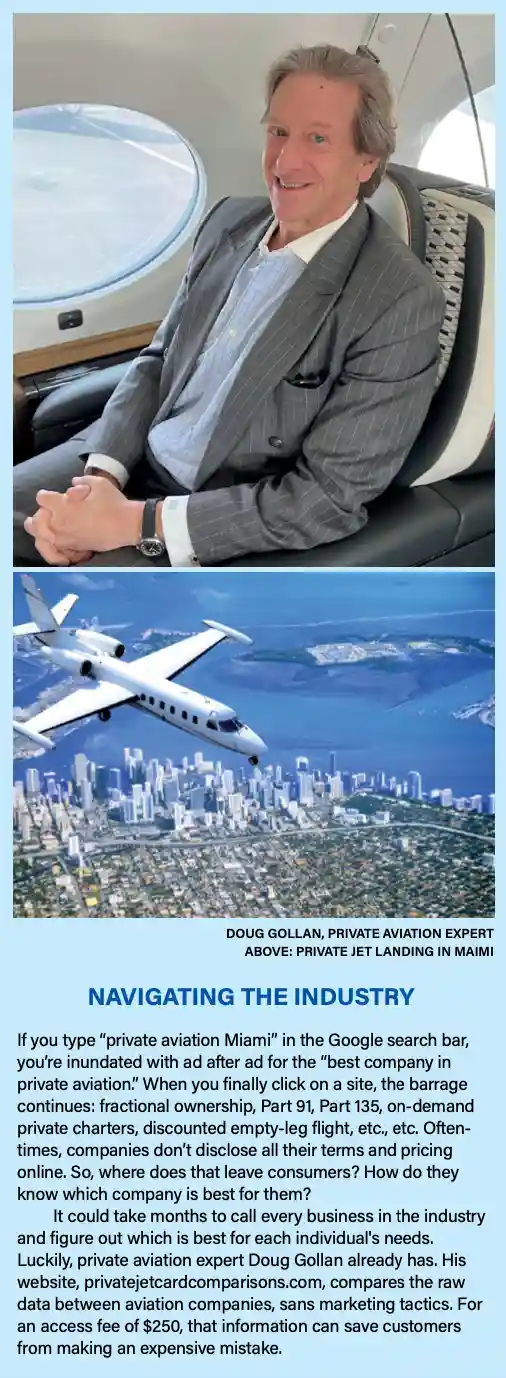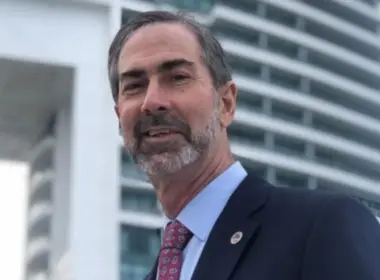Why private aviation is taking off in Miami
By Katelin Stecz
When former NBA player Baron Davis, pictured above, stepped out of his car and strolled into the Santa Monica Municipal Airport, he was greeted with a bottle of water and a comfortable place to sit. After relaxing in the lobby for 15 minutes, he boarded one of Verijet’s Cirrus Vision Jets and then took a two-hour nap. When Davis woke up, he was in Salt Lake City, his car service waiting to take him to All-Star Weekend.
If Davis had decided to fly commercially, he would’ve had to arrive at LAX two hours before his flight and deal with airport crowds, potential flight delays, and the possibility of lost luggage. For the NBA record-holder and entrepreneur, convenience, time savings, flexibility, and comfort are just a few of the reasons he chooses to fly private.
Before COVID hit, many travelers thought private aviation was something reserved for NBA players, celebrities, and the Jeff Bezoses of the world. When commercial airports turned into breeding grounds for the virus, however, a wider swath of travelers looked to private aviation for an escape.
Kevin Diemar, CEO of Unity Jets, says the pandemic drove many first-class passengers to reevaluate how they flew. “COVID introduced a lot of people to private aviation,” says Diemar. “I think there were a lot of people who had the financial means to fly privately but couldn’t justify the cost in the past.”
PRIVATE AVIATION… AFFORDABLE?
For most, private aviation seems out of reach, so it’s hard to believe that the words “private aviation” and “affordable” would appear in the same sentence. But, depending on what flavor of private aviation you choose, the price point might be more affordable than previously thought.

For the traveler looking for the best value, Unity Jets, one of the largest self-proclaimed wholesale brokerages in the country, prides itself on affordability. Unity leverages its relationships with operators to get clients the best prices. In terms of value, Diemar says his company is your best bet.
“Obviously, it’s still expensive to fly privately. I can’t eliminate the cost. But if you’re looking for value and experts in the business, there’s no team like ours,” the CEO says.
As a brokerage, Unity essentially does all the shopping for its clients. Need a plane for an impromptu golf trip this weekend? Want your jet moved to a different departure airport? Bringing the family dog? Unity takes all of this into consideration and helps find the best jet for the client’s needs.
Diemar points out that his company differs from other large brokerages in that Unity doesn’t require the same long-term contracts or hefty financial obligations that many others do. There are no upfront membership costs and no peak day restrictions. And Diemar and his team’s collective knowledge of the aviation industry is an invaluable resource. Before founding Unity, Diemar was a sales executive at NetJets and worked with Marquis Jets.
“What I think is most important is we know who to do the shopping with and who to stay away from,” says Diemar. “We can do whatever you need. So, whether you take two trips a year or you take two trips a month, we’re still a good resource for you.”
FLYING GREENER AND MORE EFFICIENTLY

Assuming it’s affordable, what about some of the other negatives, namely the huge carbon footprint private aircraft create? Richard Kane, the founder and CEO of Verijet, has a solution for that. He aims to show the industry that private aviation can be done in a way that’s less harmful to the environment, and he plans on doing this with smaller, better-designed aircraft.
Kane’s air taxi service exclusively offers the Cirrus Vision Jet for charter. This single-engine, single-pilot jet is lightweight (made from carbon fiber) and uses significantly less fuel than its twin-engine counterparts. According to Kane, on a flight from Santa Monica to Las Vegas, a Cirrus Vision Jet only uses 60 gallons of fuel – a Challenger uses 300.
Not only does Kane think the Cirrus Vision Jet will make private aviation more sustainable, he also believes that it makes it more accessible. Thanks to its ability to use short runways, the Cirrus can land at significantly more airports than commercial aircraft – about 5,400 airports across the country compared to roughly 500 for commercial aircraft. Additionally, the larger airports are where commercial jetliners land often get backed up and face “traffic jams,” so access to smaller airports also saves time.
Verijet currently has 23 jets for charter, and it recently expanded service to Central America, northern South America, and more of the Caribbean. The fixed rate is $4,000 an hour with a minimum of one hour, and Verijet’s jet card starts at $3,500 an hour.
SAVING EVEN MORE TIME
Even being able to utilize all of the small airports around the nation, passengers can still face ground traffic. So, instead of sitting in traffic for hours and feeling your blood pressure rise, imagine soaring over lines of cars and landing in your backyard in the ultimate UberX of the sky, a Flexjet helicopter.

Eli Flint, Flexjet’s private helicopter president, says that Flexjet’s new helicopter operation provides passengers the last mile transport from landing strip to backyard. And, depending on where you’re located, that last mile can be quite long.
“Most people are getting in our helicopters to save time, and for a lot of clients, time is money, so the fact that we have the flexibility to land in someone’s backyard is huge,” says Flint. While some of Flexjet’s clients use its helicopters for that last stretch home, some of them also take advantage of the helicopter’s 300 nautical mile range. “We’re breaking a lot of the stereotypes that come with helicopters. After people ride in one of our Sikorsky S76s, they realize how comfortable it can be,” says Flint, referring to its premium leather seats, teakwood and chrome accents, and sound-reducing blades. Flint says his helicopters are the same model used by the former Queen of England.
Flexjet currently offers its helicopter operation out of Miami, New York, and London. Helicopters can be chartered at about $9,500 an hour, or clients can invest in fractional ownership.
BUYING PRIVATE
A large part of the private aviation industry revolves around chartering aircraft for business meetings and weekend jaunts, but frequent fliers might consider buying. However, navigating the market can be a herculean task. Enter Sam Lechtner, broker for L&L International Ltd.

As a broker, Lechtner’s job is to do the shopping for his clients. He spends his days searching for the best planes to buy as well as finding buyers that might be interested in his clients’ planes. On any given day, he’ll be on the phone for over eight hours and take close to 50 calls. For Lechtner, that’s just a part of L&L’s commitment to its clients. “When you think about it, we’re kind of like real estate agents. We help our clients sell planes when they’re ready to move on, and if they’re in the market for one, we help them find what they’re looking for at the best deal,” says Lechtner.
Like a home or any other major investment, of course, there are added responsibilities that come with ownership as opposed to renting or chartering, but those looking for convenience might find buying their own plane worth it. “With owning, of course, you have the headaches that come with ownership, but you’re not at the whim of a charter company. Your plane is always available,” says Lechtner. “It’s there when you need it, and it can go when you need to go.”
Lechtner also mentions that for passengers doing a lot of flying – over 150 hours a year for a ballpark estimate – owning a plane could be more cost-effective in the long run. And with ownership comes the added benefit of deducting the plane’s depreciation from taxable income.
When it comes to owning, there are a few things buyers should consider – particularly, how do they plan on operating their plane? Under the Federal Aviation Administration’s safety protocols, the private aviation industry is divided into two parts, Part 91 and Part 135.
Under Part 91, you’re operating your private plane for your own business or personal use. Your pilot and aircraft do not have to adhere to the more stringent rest requirements as in Part 135, which applies to charters. If buyers plan to offset some of the aircraft’s cost with charters, then Part 135 requires the aircraft to be better maintained and that pilot and crew have longer rest requirements.
Part 91 and Part 135 aside, buying an aircraft is a decision with a multitude of factors to consider. To avoid getting lost in the nuances of the industry, many buyers consult a brokerage company like L&L International.
PRIVATE AVIATION IN MIAMI

Since 2019, the private aviation industry has seen massive growth, but Miami especially has witnessed the industry’s takeoff. Fabio Alexander Vasquez, the CEO of Executive Air Services, started his firm two decades ago at Miami-Opa Locka Executive Airport. At that time, the airport had a much different reputation than it does now. Vasquez references the Netflix documentary “Cocaine Cowboys” and says that after the Drug Enforcement Agency began to crack down at Opa-Locka, the airport began to see more legitimate business. “Opa-Locka was not what it is now. When I started, no one wanted to be there. It took a while before it started to be a location,” says Vasquez.
He notes that Miami’s “avenues of fun,” as well as its post-COVID boom and welcoming attitude toward business and corporate executives relocating here has boded well for the private aviation industry. “Miami has a lot going for it right now: Formula 1, the NBA Finals, our hockey team doing well, and now, in four years, we’re going to get the World Cup. All of this just brings more attention to Miami, which brings more high-net-worth individuals, and those individuals bring more airplanes.”
Vasquez is also quick to mention that Miami’s proximity to Latin America and its growing tech sector are huge draws for companies looking to tap into a new market. “Before, we were a destination. Now, we’re a place to do business,” says Vasquez.
Canada’s Bombardier, one of the largest producers of corporate aircraft in the world, is a testament to just how far private aviation has grown in Miami. Last year, the Montreal-based firm invested $100 million in a new 300,000-square-foot facility at the Opa-Locka airport. According to the company, its new facility will quadruple Bombardier’s maintenance footprint in Florida.
Bombardier will continue offering maintenance services at Fort Lauderdale-Hollywood International Airport, but its new location in Miami has expanded capabilities for quick and efficient maintenance, repair, and overhaul, including a paint shop. The facility can service more than 24 aircraft of various models, including some of Bombardier’s well-known business jets like the Learjet, Challenger, and Global aircraft.
“The U.S. is an important market for Bombardier, with close to 3,000 aircraft in our fleet, and this highly-efficient facility provides a key focal point for customers based in the area and those who will visit from as far as Latin America,” said Éric Martel, president and CEO. Opa-Locka was chosen for Bombardier’s expansion because, “the city of Miami is a vibrant, international hub of business and commerce,” says Martel. The facility is set to provide around 300 jobs to Miami in the next five to seven years.

As private aviation continues to grow and thrive in Miami, it’s places like Opa-Locka and the convenience they provide (there is also Miami Executive Airport and Homestead General Aviation Airport) that will attract a slew of new corporate users, bring hundreds of high-paying jobs, further facilitate international commerce in Miami, and solidify its position as a truly international city. As Verijet’s Kane puts it, “A small airport close to the origin, a small airport close to the destination, no traffic jams. It’s that simple.”












